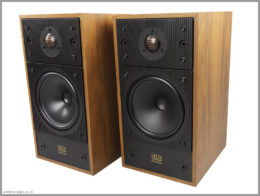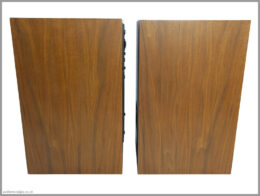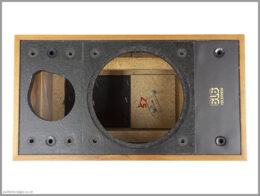TABLE OF CONTENTS
MY STORY WITH CELESTION SL6
Since hearing the Ditton 44 for the first time and later owning Celestion Ditton 66, I always had a soft spot for Celestion loudspeakers. I was mainly familiar with their models from 1970s and did not know much about their later constructions. It wasn’t until recently, when I was browsing the Internet looking for speakers with similar character of sound to Harbeth, and I came across the Celestion SL6. I don’t remember exactly where I found it, but it was a comment made specifically about the original version of the SL6 with the copper coloured tweeter; not the upgraded Celestion SL6S version with its silver colour tweeter. It was implied that the original SL6 version is very easy to listen to and has a really nice midrange. These are the two qualities often associated with Harbeth loudspeakers. This was enough to pique my interest, and not long after I ended up purchasing a set of Celestion SL6 from eBay.
Please note – usually before reviewing vintage speakers, I recap the crossovers to ensure that capacitors are within manufacturer’s specification. On this occasion, caps were within the specs, so there was no need to replace them. Also, bear in mind that purchasing vintage speakers is always a gamble. 30 and often 50 years it’s a long time, and one can never be sure how this time affected the loudspeaker drivers. Consequently, it is possible that the Celestion SL6 that you have purchased will measure and sound different than the pair I reviewed.
SPEAKER INFO
Celestion SL6 were launched in the early 80s as a higher end addition to their popular Ditton range from that era. The engineers from Celestion used some pretty advanced techniques (such as optical interferometry) to get the best from a relatively small 2 way speaker.
A 6.5″ bass driver was developed where the shape of the cone and dust cap, as well as suspension and voice coil termination, were all designed to reduce distortion. Similar approach was used during tweeter design process, which resulted in a 1.25″ dome tweeter with diaphragm made of ultra thin aluminium extended to form the voice coil. The design choices described above, combined with a fairly small sealed cabinet, resulted in Celestion SL6 having low distortion, but relatively low sensitivity and limited bottom end extension.
CELESTION SL6 SPECS
| Frequency Response: | 60 – 20,000Hz (+/- 6dB) |
| Sensitivity: | 82dB (1W input, measured at 1m) |
| Impedance: | 8Ω (4Ω min.) |
| Power Capacity: | 100W |
| High Frequency Driver: | T3506 32mm (1.25″) Aluminium Dome |
| Low Frequency Driver: | T3507 165mm (6.5″) PVC Diaphragm |
| Crossover Frequency: | 2,300Hz |
| Enclosure Type: | Closed |
| Enclosure Dimensions (HxWxD): | 370x200x255mm (14.5x8x10″) |
| Weight: | 8.4kg (each speaker) |
| Production Year: | 1982 |
| Price When Launched: | £250 for a pair |
| Equivalent Present Day Price: | £970 for a pair |
| Current UK Price: | £200 to £400 for a pair |
LOOK & FEEL OF CELESTION SL6 SPEAKERS
These relatively small bookshelves are quite easy on the eyes, thanks to the good proportions of the driver size to the enclosure dimensions. The cabinets are made of 19mm chipboard and veneered on both sides in case of sides, tops and bottoms. Front and back panels are not veneered, and instead, are painted black on the outside surfaces. There is internal chipboard bracing attached to the side walls. To further reduce vibrations, dynamat-like damping panels are attached to internal walls (visible on the photos). Enclosures are loosely packed with two polyester sheets, however, these are not visible on the photos as they were removed to allow internal cabinet photographs.
The Celestion SL6 crossovers are setup on printed circuit boards (PCB) and feature a mix of polypropylene and electrolytic capacitors, as well as a mix of an air-core and ferrite-core inductors. All connections are soldered, with an exception of where the crossovers connect to the speaker terminals and directly screw down onto the input terminals with eyelets on the PCB. All crossover components are set on foam pads to reduce the vibration – nice attention to details from Celestion.
Same attention was given to Celestion SL6 drivers, which are indeed very well made. Apart from enhancements briefly covered in the previous paragraph, it is worth to mention that the woofers feature a really rigid die cast alloy baskets with a lot of ‘breathing’ space and fairly substantial ferrite magnets. Tweeters feature an integrated grille which I presume not only protects the frigate aluminium dome, but also acts as a acoustic lens. The diaphragm with its grille is attached directly to the tweeter face plate. Both the woofer (T3507) and the tweeter (T3506), have seals on the back, which aids with creating air-tight cabinets. All in all, Celestion SL6 are pretty well made loudspeakers.
SOUND OF CELESTION SL6
First Impressions
I first connected these on the side of my Harbeth M40.1. It is not often that on a direct comparison any Harbeth speakers sound bright, but to my surprise, this was very much the case when I tested them against Celestion SL6. On the other hand, when I switched from Harbeths to Celestions, the SL6 sounded a little closed-in. However, this impressions quickly went away after a couple of minutes of listening. I removed my main speakers out of the way, and concentrated on listening to the Celestion SL6.
Bass
If you are, similarly to me, used to large speakers with good low-end extension, you will immediately notice that deep bass is not something that you can expect from these little bookshelf speakers. Not really a surprise from a 12l enclosure with a 6.5″ driver. Saying that, it is not something that goes away. For instance, other small speaker such us Audiomaster MLS1 do a better job of fooling you that they go deeper than they actually do. This means that once you get used to their sound, you don’t have a feeling that things are missing at this end of the audio spectrum. With Celestion SL6, you don’t really get that. The bass is light and you are aware of it on tracks such as Darling Cory by Chris Jones, where the bass guitar sounds a little artificial due to lack of weight. You also notice this on tracks that feature pianos. If you listen to a lot of music with heavy bass content, you will find yourself turning up the volume to compensate for lack of bass. Just be careful – although the speakers are capable of handling quite a lot of power, the maximum SPL is limited. Thus, if you turn it up to much, you will hear the woofer’s voice coil hitting the end of the magnet gap. Even though the bass extension is limited, the bass produced by these speakers is of a good quality and has some punch to it. Obviously it is not going to be the visceral experience that you get from large drivers in large cabinets, but it is not bad for a small monitor type speakers. Moreover, missing low end extension does not make these Celestion SL6 unlistenable. For instance, Tannoy Little Gold Monitor have limited bottom end extension and relatively bright top end, which makes them rather hard to listen to, on most but only the best recordings. In contract, Celestion SL6 have somewhat recessed treble, which despite not having much bass, makes them quite easy to listen to.
Midrange and Treble
Midrange and treble are of a very high quality. The speakers are voiced in a way which favours mid-band over the treble, which results in couple interesting things. First, it makes the speakers very forgiving – probably the most forgiving speakers I have ever listened to (I had similar impressions with Magnepan LRS). This means that you can turn them up to a fairly loud level, and even with average quality recordings, they never sound ‘ear-piercing’. Unfortunately this also means that they are not the most engaging to listing at low volumes. Second interesting thing is that it changes the presentation of the recordings, which in some cases can be beneficial and in others, not. For instance, the voicing of the Celestion SL6 seems to favour live recordings such as People Get Ready by Eva Cassidy, where they separate the vocals nicely and make the recording really engaging to listen to. On the other hand, on the live tracks such as Hold On by Teskey Brothers, the vocals seems to be dominating the recording, with clapping and all background noises being quite withdrawn, which takes away something from the atmosphere of the recording.
Vocals are a joy to listen to on the Celestion SL6 – they sound smooth and realistic. Due to the recessed treble, they have a lot less sibilance than on other speakers that I am accustomed to. This makes the harsher recordings nicer to listen to, but it also makes the really well recorded tracks sound a little closed-in. Strangely though, despite rolled off treble, they still provide quite a lot of ‘air’ around the vocals. This may sound a little contradictive if you consider my statement above, related to background of the recordings. The ‘air’ I’m referring here is more of a function of a detailed midrange reproduction rather than amount of treble. I’m talking about the sense of the space where the vocalist is singing. It is rather difficult to put that sensation into words, but it definitely contributes to the beautiful vocal reproduction of the Celestion SL6.
The string instruments sound a little timid and not as realistic as on other speakers. For example, in the song Where Shall I Be by Eric Bibb, it is much harder to hear the fingers moving on the strings and the guitar does not sound as vivid and real as what I am used to. Woodwind instruments and clapping sound surprisingly real despite the rolled off treble.
Soundstage
The Celestion SL6 are capable of creating a deep and wide soundstage and they image really well too, which further contributes to the listening engagement. Moreover, what took me by surprise is how composed these sound for a 2 way system. A lot of small bookshelf speakers tend to sound ‘out of their comfort zone’ when you turn up the volume on a pretty heavy track. This is not the case with Celestion SL6 – when I played Lighters Up by Lil’ Kim, I was surprised how well they handled it providing I did not go crazy with the volume control. Yes, they may not have separation as larger 3 way loudspeakers, but still pretty impressive for a small 2 way.
To conclude – I really like the sound of Celestion SL6. Yes, their recessed treble is a double edge sword, however, all loudspeakers are a compromise, and I’d be happy to live with the compromises that Celestion engineers made with the SL6. If I was to use them as my main speakers, I’d probably experiment with adding a subwoofer, to provide them with much needed low end extension.
CONCLUSION
Celestion SL6 are pretty little bookshelf speakers with a very forgiving sound balance. Even with their limited bottom end extension, thanks to their recessed treble and realistic and beautiful midrange, they are very easy to listen to. These qualities don’t make them the best at quiet listening, so to get the best out of Celestion SL6, you need to turn up the volume. With an addition of a subwoofer, I’d be happy to use them in my system.
| Balance of Sound: | |
| Neutrality of Tone: | |
| Transparency: | |
| Soundstage: | |
| Attack: | |
| Engagement: | |
| Total Score: |
SONGS MENTIONED IN THIS REVIEW
Chris Jones – Darling Cory
Eva Cassidy – People Get Ready
Eric Bibb – Where Shall I Be
Lil’ Kim – Lighters Up
Teskey Brothers – Hold On
Reviewed: February 2021 | Published: February 2021











